The impact of a tailored Mind-Body Wellness Intervention:
A Case Study in Applying Neuroscience to the Cosmetics Industry
LAURA GAMBOA1*, MERITXELL LLINÀS1, GINA PUIG1, PATRICIA FISAS1, ANGEL BLANCO2,
ELENI KROUPI2, AURELI SORIA-FRISCH2, MARINA LOPEZ-ARJONA3
*Corresponding author
- Natura Bissé Int. S.A. Spain. I&D&R Department, Wellness & Spa Development Department, Catalunya, Spain
- Starlab Barcelona SL, Catalunya, Spain
- Universidad de Murcia, Interlab, Murcia, Spain
ABSTRACT:Our study examined the impact of a tailored Wellness Mind-Body Intervention (WMBI) or Spa treatment on emotions, well-being, and skin health using aromatherapy, skincare, and touch. Thirty participants underwent a crossover study measuring EEG, ECG, stress biomarkers, emotional state, and skin condition before and after treatment or a control resting condition. Results showed a 67.87% increase in well-being after treatment, with a 72.51% decrease in the control session. Relaxation features, self-acceptance (Ryff model), and skin condition improved significantly after treatment but not after the control session. Lower oxytocin levels correlated with higher stress. The findings highlight Spa treatment’s potential to enhance emotional well-being and skin health through multi-sensory stimulation.
Adapted version of (Designing Wellness Mind-Body Interventions using neuroscience, artificial intelligence and the power of touch: measurements in real time to ensure skin and emotion transformation), with permission from the original authors (1).
??????????????????
“
“A study in healthy women providing probiotic yogurt for four weeks showed an improvement in emotional responses as measured by brain scans”

Figure 1. Skin Section with Microbiome. Most microorganisms live in the superficial layers of the stratum corneum and in the upper parts of the hair follicles. Some reside in the deeper areas of the hair follicles and are beyond the reach of ordinary disinfection procedures. There bacteria are a reservoir for recolonization after the surface bacteria are removed.
Materials and methods
Studies of major depressive disorder have been correlated with reduced Lactobacillus and Bifidobacteria and symptom severity has been correlated to changes in Firmicutes, Actinobacteria, and Bacteriodes. Gut microbiota that contain more butyrate producers have been correlated with improved quality of life (1).
A study in healthy women providing probiotic yogurt for four weeks showed an improvement in emotional responses as measured by brain scans (2). A subsequent study by Mohammadi et al. (3) investigated the impacts of probiotic yogurt and probiotic capsules over 6 weeks and found a significant improvement in depression-anxiety-stress scores in subjects taking the specific strains of probiotics contained in the yogurt or capsules. Other studies with probiotics have indicated improvements in depression scores, anxiety, postpartum depression and mood rating in an elderly population (4-7).
Other studies have indicated a benefit of probiotic supplementation in alleviating symptoms of stress. In particular, researchers have looked at stress in students as they prepared for exams, while also evaluating other health indicators such as flu and cold symptoms (1). In healthy people, there is an indication that probiotic supplementation may help to maintain memory function under conditions of acute stress.
Introduction
Mental wellness is a fundamental pillar of overall health and well-being (2). This article explores how neuroscience, the power of touch, and artificial intelligence can come together in the cosmetics industry to create treatments that not only enhance well-being but also deliver scientifically validated results.
Stress can negatively impact the skin, worsening existing conditions or causing further damage (3,4). However, targeted interventions have been shown to improve skin health, alleviate stress, and promote relaxation (5,6,7,8). Healthy skin, in turn, enhances self-esteem and appearance satisfaction (9,10), while sensory experiences, such as touch and smell, offer psychological pleasure (11).
To better understand these connections, we employed a combination of advanced tools and techniques. Saliva, a non-invasive and practical sample, allowed us to measure biomarkers related to emotional states (oxytocin) and stress (cortisol, alpha-amylase) (12,13). Electrophysiological methods, such as EEG and ECG, further supported emotional state evaluation (14).
This study investigated the effects of professional Spa treatments, including facial skincare, face and body massages (6,15,16,17), on participants' well-being, emotions, and skin condition. We assessed outcomes using both subjective measures (self-assessments) and objective metrics, including EEG, ECG, GSR, biomarkers, skin imaging (VISIA®) (18), and an AI-based algorithm to quantify well-being before and after treatment.
Materials and Methods
Proof-of-Concept:
A multimodal, open-label study with 20 participants tested 12 Wellness Mind-Body Interventions (WMBI), including skincare, aromatherapy, and touch (19,20,21). EEG, ECG, and GSR signals were recorded before, during, and after each intervention using Enobio® (8-channel, 7 EEG-1ECG) (22) at 500 Hz sampling and Shimmer® device for GSR acquisition. A 2-minute baseline was collected with participants lying on a treatment bed with closed eyes to estimate their initial emotional state. Emotional analysis used the circumplex model dimensions of valence (pleasantness) and arousal (activity) (23,24). For example, high valence/low arousal indicates relaxation, while high arousal/low valence suggests nervousness. Features derived from electrophysiological signals were processed using the WEEmo® algorithm to quantify emotional states based on valence and arousal.
Study:
Thirty volunteers participated with informed consent.
Subjective Measures:
- Well-being: A 17-question Spanish Ryff test (25) was used, rated on a 0–5 scale (0 = Strongly Disagree, 5 = Strongly Agree).
- Stress Perception: An 11-question Spanish test rated on a 1–3 scale (1 = Nothing, 3 = High).
- Skin Evaluation post-session: An 11-question Spanish test rated on a 1–4 scale (1 = Strongly Disagree, 4 = Strongly Agree).
- Emotional State: An adapted Affective Slider (26) in JotForm (27) assessed arousal and valence using two sliders on a 0–100 scale (0 = lowest, 100 = highest). Questions evaluated arousal/activation/sleepiness and valence/pleasantness.
Electrophysiological Measures: EEG data were acquired using Enobio® (19 channels: P7, P4, Cz, Pz, P3, P8, O1, O2, T8, F8, C3, F4, Fp2, Fz, C4, F3, Fp1, T7, F7) (28) with CMS/DLR electrodes on the right mastoid and an ECG electrode on the left wrist, sampling rate at 500 Hz. A six-minute protocol alternated 30-second resting-state eyes-open/eyes-closed sessions, guided by Spanish audio and visual cues on a black screen. The sequence, programmed in Scilab (29), synchronised EEG markers with visual/audio instructions via Lab Streaming Layer (LSL) (30) for real-time data and trigger streaming.
Protocol: Participants completed a crossover study with two sessions, each involving a treatment or control condition. Sessions occurred in the same environment, day, time, room, and with the same aesthetician, with randomized session order across participants.
Session Conditions:
- Treatment: Dim lighting, 22°C ± 1.5°C, bed warmer, music, and skincare applied by hand.
- Control (No-Treatment): Dim lighting, 22°C ± 1.5°C.
Procedure:
- Pre-Session: Participants completed the Ryff test, VISIA® skin imaging, a stress test, and saliva collection. EEG/ECG setup followed, with a six-minute alternating eyes-open/closed recording.
- Session: Participants received a 50-minute treatment or rested for 50 minutes on the treatment table.
- Post-Session: A second saliva sample, adapted Affective Slider test, EEG/ECG recording, VISIA® imaging (31), and questionnaires (Ryff, stress, skin evaluation) were completed, with a final saliva sample collected.
This protocol ensured consistent measures of well-being, skin condition, and emotional state.
Analysis:
Affective Slider Analysis: Pre- and post-condition responses were rescaled between -1 and 1 to fit Russell’s Circumplex model of affect (23).
Ryff Test Analysis: The 17 Ryff test questions were grouped into four dimensions: Autonomy, Self-Acceptance, Environmental Mastery, and Life Purpose. Responses (0–5 scale) were grouped within these dimensions and averaged to compute a unique value per dimension.
ECG Analysis: The ECG signal was processed with a 0.5 Hz high-pass Butterworth filter and a 50 Hz notch filter to remove noise and power line interference. Signals were segmented into 30-second epochs for eyes-closed and eyes-open conditions. Epochs exceeding 1 mV amplitude were removed as artefacts. Heart rate, linked to arousal (32), was calculated by detecting R-peaks within QRS complexes. The average interval between normal beats (NN intervals) was computed for each session.
EEG Analysis: Raw EEG data (1–45 Hz) was filtered, epoched, and segmented into 4-second epochs with 2-second shifts. Artefacts exceeding 100 µV were removed. Frequency band powers (delta: 1–4 Hz, theta: 4–8 Hz, alpha: 8–13 Hz, beta: 13–30 Hz, gamma: 30–45 Hz) were extracted. Following this, valence and arousal features were computed for each sub-epoch and averaged for each condition and event (33), using the proprietary EmoWave® pipeline.
- Arousal (23,24): Calculated from frontal theta, alpha, and beta power (34,35,36,37).
- Valence (23,24): Derived from gamma and alpha asymmetry (34,36,37,38,39).
The percentage change between the pre- and post-condition of the arousal and valence measures for each participant wererescaled pre- and post-condition values (-1 to 1) were projected onto Russell’s Circumplex model. Relaxation, happiness, harmony, satisfaction, and activation were computed as vector projections, with a final well-being marker (WEEmo®) calculated as their linear combination.
Stress Biomarkers Analysis: Saliva samples were collected pre-session, immediate post-session, and 30 minutes post-session to evaluate biomarkers with delayed expression. Participants provided saliva via passive drool into polypropylene tubes for 1 minute, avoiding smoking, eating, drinking, or brushing teeth for 30 minutes prior. Samples were stored on dry ice and later at -80°C in the laboratory (Interlab-UMU, Murcia, Spain).
- Cortisol: Measured using an automated immunoassay system (IMMULITE, Siemens Healthcare Diagnostics) (12).
- Salivary Alpha-Amylase (sAA): Assessed via a kinetic spectrophotometric assay with a commercial kit following the International Federation of Clinical Chemistry and Laboratory Medicine method (12,13), using ethylidene-G7PNP as the substrate.
- Oxytocin: Measured with an Alpha-Lisa assay using a monoclonal antibody against antioxytocin.
All assays demonstrated intra- and inter-assay coefficients of variation (CVs) below 10%, with linear regression coefficients near 1 after serial dilutions.
Skin-Condition Analysis:
- Objective Evaluation: Skin was assessed before and after sessions using the VISIA® skin analysis system (18). Images provided percentile scores comparing participants’ skin features (e.g., wrinkles, pores, redness) to a database of individuals of similar age and skin type. Higher scores indicated better skin condition, with 50% representing the average. Pre- and post-session percentile differences for treatment and control sessions were analyzed using a paired Student’s t-test, with p-values < 0.005 considered statistically significant.
- Subjective Evaluation: Participants completed 11-question test rating skin condition aspects such as luminosity, lifting effect, hydration, and overall appearance. Each question was scored on a 1–4 scale (1 = lowest satisfaction, 4 = highest).
Statistical Analysis:
A 2 × 2 Repeated Measures ANOVA analyzed electrophysiological features, Affective Slider responses, and Ryff test answers, with session (treatment, control) and condition (pre, post) as within-subject factors. Significant effects were followed by pairwise comparisons, with p-values adjusted using the Benjamini & Hochberg correction (40).
- Pairwise comparisons between conditions (pre vs. post) and sessions (treatment vs. control) were conducted using the Wilcoxon nonparametric test.
- Outliers exceeding 1.5 IQR were removed based on Tukey’s rule (41).
For biomarkers (cortisol, oxytocin, alpha-amylase), a logarithmic transformation ensured normal distribution. A mixed linear model was applied, considering session and saliva collection time (before, after, 30 minutes after) as fixed factors and individuals as random factors.
The Spearman correlation coefficient examined the relationship between salivary biomarkers and subjective stress survey results. A significance level of 0.05 was applied.
Results
Proof-of-Concept:
Figures 1A-B illustrate the average valence and arousal outcomes from the proof-of-concept study.
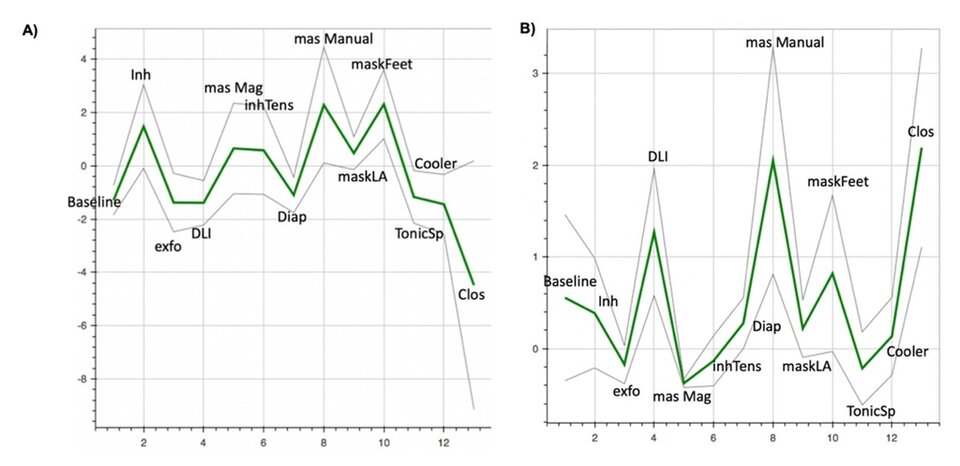
Figure 1.A) Arousal and B) Valence. The green lines depict the grand averages across all participants, while the grey lines represent the standard error of the mean.
While most steps showed high valence, indicating participants enjoyed them, two steps—exfoliation and cold toner spray—resulted in discomfort, characterized by low valence (pleasantness) and high arousal. Despite these two exceptions, baseline (pre) and post-intervention measurements demonstrated that participants felt significantly more relaxed (low arousal, high valence) after completing the Wellness Mind-Body Intervention (WMBI) series.
This study achieved two objectives:
- Demonstrating the WMBI's effectiveness in promoting relaxation (low arousal, high valence).
- Optimizing the treatment by identifying and reducing unpleasant steps for the subsequent crossover study.
Study:
Affective Slider’s Answers: Participants reported reduced arousal post-condition in both sessions, with a greater decrease after treatment (-55.51%) compared to control (-25.81%). ANOVA showed a significant condition effect (F(1) = 21.23; p < 0.0001; η² = 0.16) and a near-significant session*condition interaction (F(1) = 3.48; p = 0.07; η² = 0.01). Pairwise tests revealed significant pre-post differences for control (p = 0.0018) and treatment (p = 0.0004), but no significant difference in percentage change between sessions (p = 0.12).
Valence increased significantly post-treatment (56.18% vs. 11.32% in control). ANOVA indicated significant effects of session (F(1) = 40.78; p < 0.0001; η² = 0.26), condition (F(1) = 63.2; p < 0.0001; η² = 0.24), and session*condition interaction (F(1) = 25.29; p < 0.0001; η² = 0.15). Pairwise tests showed significant pre-post differences for treatment (p = 0.002) and between control and treatment groups in percentage change (p = 0.002).
Ryff Test Responses: Participants showed increased self-acceptance levels after treatment, unlike in the control session (Figure 2). A significant condition*session interaction for self-acceptance was found (F(2) = 7.82; p < 0.001; η² = 0.03). Pairwise tests showed significant pre-post differences only for the treatment group (p = 0.0011) and between post and 24-hour post conditions (p = 0.009). Additionally, significant differences in the percentage of change (post – pre) were observed between control and treatment sessions (p = 0.006).

Figure 2. Average of Participant’s responses to the four dimensions of Ryff Scale (Autonomy, Self-Acceptance, Environmental Mastery, and Life Purpose).
ECG Analysis: Participants showed reduced heart rates post-session, reflected by longer N-N intervals (Figure 3 A-B). A significant condition effect was observed (F(1) = 7.71; p = 0.01; η² = 0.01). Pairwise tests revealed significant pre-post differences for both control (p = 0.002) and treatment sessions (p = 0.006). Heart rate levels were lower during treatment than control sessions, indicated by a significant session effect (F(1) = 5.18; p = 0.03; η² = 0.01). However, no significant differences were found in the percentage of change (post – pre) between the two sessions.

Figure 3. A-B. Results ECG Analysis.
EEG Analysis: Topographies of each frequency band (treatment and control, eyes-open and eyes-closed) display the percentage of change (post – pre) per session (Figure 4). As expected, alpha power (8–13 Hz) increased, especially in parieto-occipital electrodes during the eyes-closed condition.
For the treatment session during eyes-open conditions, alpha power increased, whereas in the control condition, there was a slight increase in theta power and a reduction in alpha, beta, and gamma power in frontal electrodes. A similar pattern was observed for the eyes-closed control condition.
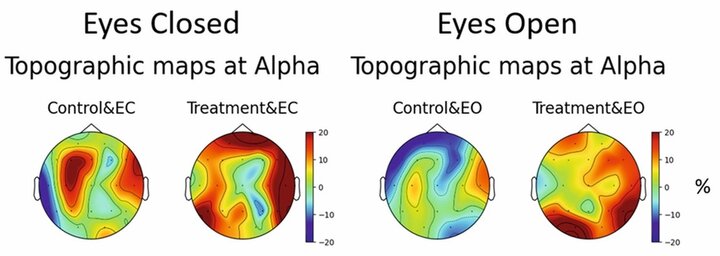
Figure 4. Percentage of Change (%) in Alpha power of Post – Pre-Conditions for Eyes Closed and Eyes Open Conditions. Comparison between Control and Treatment.
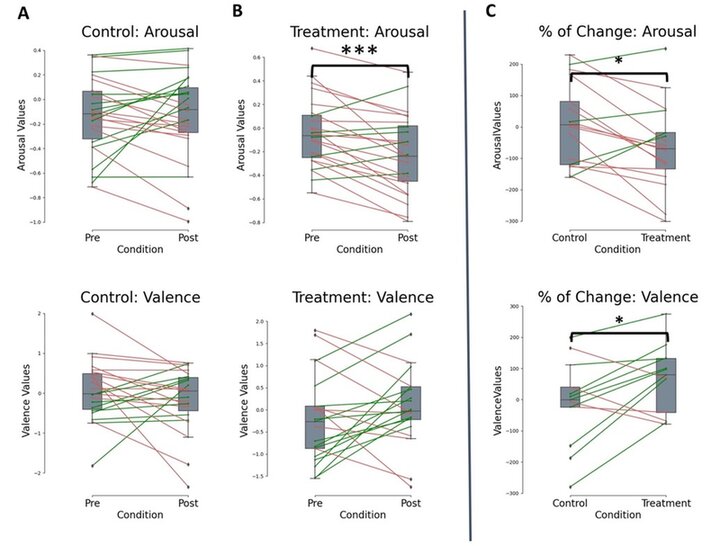
Figure 5. Arousal and Valence features extracted from EEG and ECG.
Comparison of Subjective and Objective Measures: Subjective Affective Slider responses were consistent with EEG/ECG activity (Figure 6), showing similar differences between treatment and control. After the control session, participants reported less activity but higher valence, while EEG/ECG indicated reduced valence and unchanged arousal.
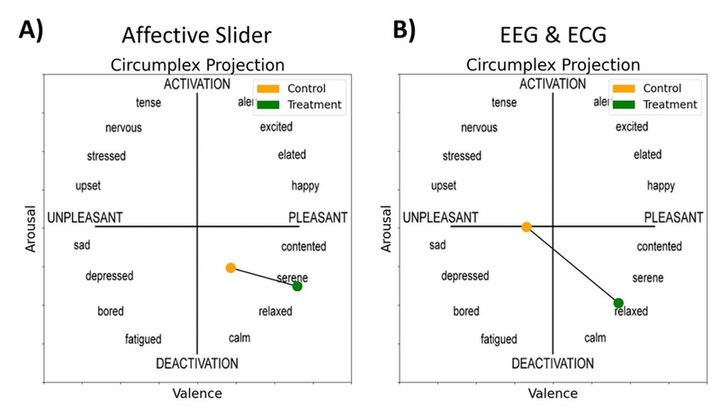
Figure 6. Circumplex projection of participants' arousal and valence levels. The center of the circumplex corresponds to the Pre-condition and the points to the Post. A. Subjective’s answers of participants using the Affective Slider. B. Objective Valence and Arousal features extracted from ECG and EEG on the same participants. Control condition appears as the orange point. Treatment condition appears as the green point.
Relaxation and Well-Being: Relaxation levels increased exclusively after the treatment session (Figure 7 A), with a significant difference in percentage change between sessions (p = 0.03) revealed by a Wilcoxon test. WEEmo® well-being levels significantly increased after treatment (+67.87%) and dropped after the control session (-72.51%) (Figure 7 B). A Wilcoxon test showed significant differences in percentage change between treatment and control sessions (p = 0.04).
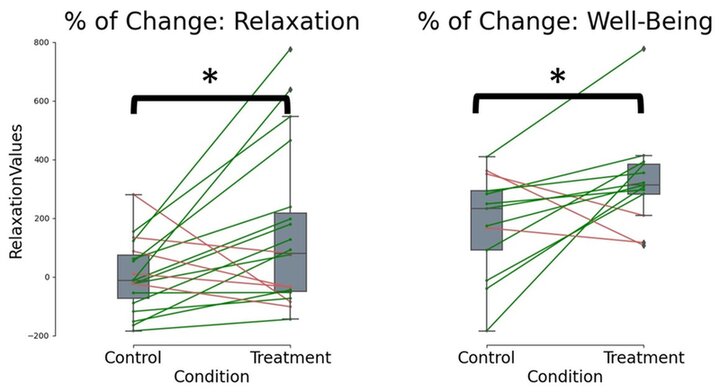
Figure 7. Relaxation and Well-Being features extracted from EEG and ECG. A) Percentage of change (Post – Pre) of the Relaxation feature. B) Percentage of change (Post – Pre) of the WEEmo® well-being feature.
Skin Analysis: Skin condition improvements were evaluated for 30 volunteers using percentile score differences for wrinkles and pores before and after both sessions.
- Pore Condition: A significant improvement (p < 0.0001) was observed during the treatment session, with a +42.9% increase over the control session (Figure 8A).
- Wrinkle Condition: No significant improvement was observed, with only a +10% increase during the treatment session (Figure 8 B).
- Subjective Evaluation: Volunteers reported full agreement (score 4) on skin improvement after treatment, compared to non-agreement (score 1) following the control session (Figure 8 C).
- Representative Case: Figure 8 D shows an example of wrinkle score improvement from a representative volunteer following the treatment session.
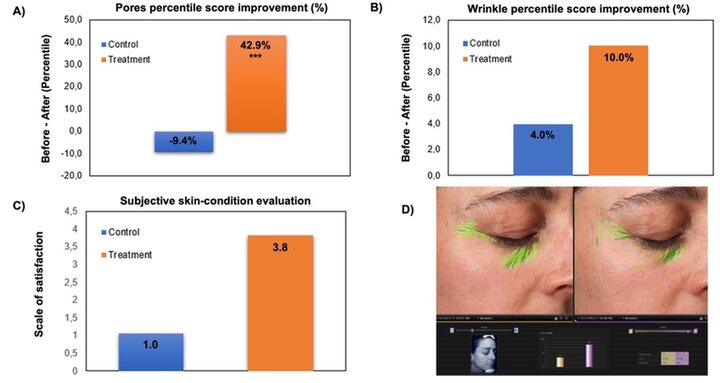
Figure 8: A) Evaluation of percentile score improvement on pores before and after control and Treatment session, ***, p-value <0.001; B) Evaluation of percentile score improvement on wrinkles before and after Control and Treatment session; C) Subjective skin-condition evaluation. Scale of satisfaction from 1 to 4 (1= total non-agreement of satisfaction on the skin condition improvement to 4= total agreement level of satisfaction on the skin condition improvement; D) VISIA® Analysis results on wrinkle percentile score improvement of a representative volunteer.
Biomarkers Analysis:
Group Analysis (Figure 9 A-C):
- Oxytocin: No significant changes between groups (p = 0.429), intakes (p = 0.823), or group*intake interaction (p = 0.680).
- Cortisol: No significant variations between groups (p = 0.324), intakes (p = 0.823), or group*intake interaction (p = 0.157).
- Alpha-Amylase: No significant intergroup differences (p = 0.870), intakes (p = 0.117), or group*intake interaction (p = 0.241).
Correlation with Stress Survey (Figure 9 D):
- A significant negative correlation was observed between salivary oxytocin levels and subjective stress survey results [39, 40] (Spearman’s coefficient = -0.217, p = 0.019).
- No significant correlation was found for cortisol (p = 0.876) or alpha-amylase (p = 0.090).
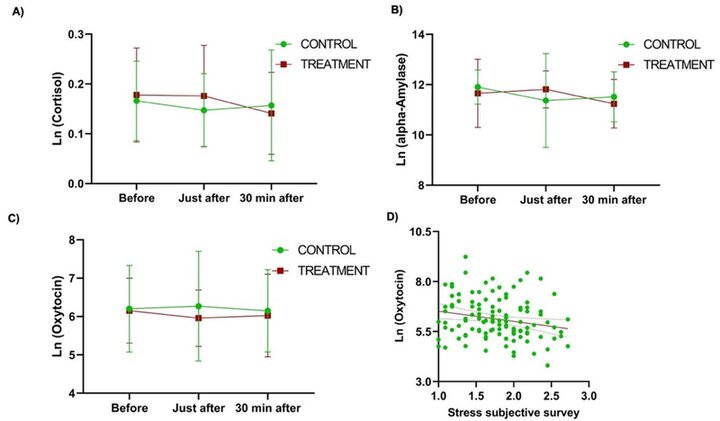
Figure 9. A) Salivary cortisol levels B) Salivary alpha-amylase and C) Salivary oxytocin levels in the treatment and control groups in saliva samples obtained before, just after session and 30 minutes after. The average values obtained after the natural logarithmic transformation of data are displayed. The error bars show the standard deviation of the data. D) Dispersion plot constructed between the salivary oxytocin levels recorded at each intake (natural logarithmic transformed) and mean result obtained in the subjective stress survey.
Individual Data Highlights:
- Oxytocin: Increased post-treatment and 30 minutes after for participants 6, 10, 13, 18, 26, and 27; no increase after control.
- Cortisol: Decreased post-treatment for participants 18 and 20; no decrease after control.
- Alpha-Amylase: Decreased post-treatment for participants 16 and 29; no decrease after control.
Discussion
The WMBI intervention, including signature skincare and manoeuvres, significantly increased valence, well-being, and relaxation while reducing arousal, supported by subjective assessments (Affective Slider, Ryff test) and objective measures (EEG, ECG). Participants reported higher valence and lower arousal after treatment, with the Ryff test showing increases in Self-Acceptance and Environmental Mastery, though these reverted after 24 hours, indicating the test’s sensitivity to short-term changes. Objective measures aligned with subjective findings: valence increased only after treatment, and relaxation improved significantly, while heart rate decreased in both sessions. Arousal levels decreased after treatment but not after control, reinforcing treatment effectiveness.
Salivary biomarkers (cortisol, oxytocin, alpha-amylase) showed no significant overall changes, likely due to high intra-subject variability. However, oxytocin negatively correlated with stress levels, consistent with its role as a positive well-being biomarker (19).
Skin analysis revealed significant pore improvement and slight wrinkle enhancement post-treatment, with subjective evaluations showing perceived improvements in lifting, luminosity, and wrinkle reduction only after treatment.
These findings suggest WMBI treatments enhance relaxation, self-esteem, and environmental mastery (42,43,44,45), potentially boosting mental health and resilience. Such interventions may act as stress buffers and empower individuals, fostering long-term well-being (2, 46).
Conclusion
Optimising WMBI-Spa treatments based on steps that enhance relaxation and pleasure can significantly improve well-being outcome. Our results demonstrated clear differences in the chosen test parameters under treatment as compared to no treatment conditions. Spa treatment (47) increased relaxation, alpha waves, well-being, skin pore reduction, self-acceptance, and environmental mastery. Some improvements correlated with decreased stress biomarkers and WMBI scores. Participants also reported enhanced self-care and beauty perceptions.
Overall, the treatment improved mood, positive self-perception, and goal-attainment abilities, highlighting its potential to enhance well-being both in clinical settings and beyond.
Acknowledgments
The authors extend their gratitude to Elsa Vilà, Milva Ariza, and Elena Gómez for performing the WMBI and controlling the experience in the treatment room. Special thanks also to Sofía González and Karan Chugani who assisted during the study data collection and results analysis. Furthermore, we express our appreciation to all the participants who took part in this study, as well as to Anna Mosquera for her diligent document review.
Conclusion
The future of cosmetics lies in the continued evolution of holistic approaches which represents a transformative shift in the industry, merging scientific advancements, natural ingredients, and wellness principles. By understanding and embracing the interconnectedness of these elements, the cosmetics industry can cultivate products that not only enhance external beauty but also contribute to the overall well-being of individuals and the planet.
The interplay between beauty from within and topical cosmetics is the key for future products. The integration of biotechnology and green chemistry is revolutionizing cosmetic formulations, offering sustainable and biocompatible alternatives.
Developers can implement blockchain to trace the journey of ingredients from source to product. Nevertheless, the efficacy of the natural products should be scientifically proven. Marketers can communicate transparency as a brand value, and parallelly educate consumers by highlighting how specific ingredients contribute to radiant and healthy skin.
By embracing the synergy between these approaches and leveraging scientific advancements, the cosmetics industry can provide consumers with comprehensive beauty solutions that cater to both internal and external dimensions of beauty.
Surfactant Applications
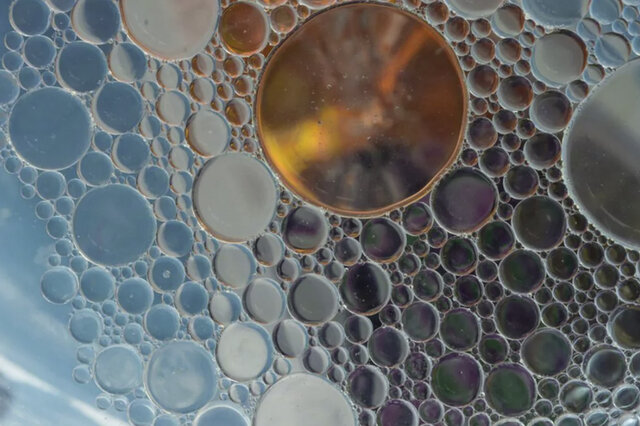
The application area lends itself particularly well to the use of AI. Active today in this area is the US company Potion AI (6). The company provides AI-powered formulation tools for beauty and personal care R&D. Their offerings include Potion GPT, next generation ingredient and formula databases and AI document processing. Potion’s work could have a significant impact on the entire surfactant value chain, from raw material suppliers to end consumers. By using their GPT technology, they can help target work toward novel surfactant molecules that have optimal properties for specific applications. By using their ingredient and formula databases, they can access and analyze a vast amount of data on surfactant performance, safety, and sustainability. By using their AI document processing, they can extract and organize relevant information from patents, scientific papers, and regulatory documents. These capabilities could enable Potion AI's customers to design and optimize surfactant formulations that are more effective, eco-friendly, and cost-efficient. A particularly interesting application for this type of capability is deformulation.
Deformulation is the process of reverse engineering a product's formulation by identifying and quantifying its ingredients. Deformulation can be used for various purposes, such as quality control, competitive analysis, patent infringement, or product improvement. However, deformulation can be challenging, time-consuming, and costly, as it requires sophisticated analytical techniques, expert knowledge, and access to large databases of ingredients and formulas.
AI can potentially enhance and simplify the deformulation process by using data-driven methods to infer the composition and structure of a product from its properties and performance. For example, AI can use machine learning to learn the relationships between ingredients and their effects on the product's characteristics, such as color, texture, fragrance, stability, or efficacy. AI can also use natural language processing to extract and analyze information from various sources, such as labels, patents, literature, or online reviews, to identify the possible ingredients and their concentrations in a product.
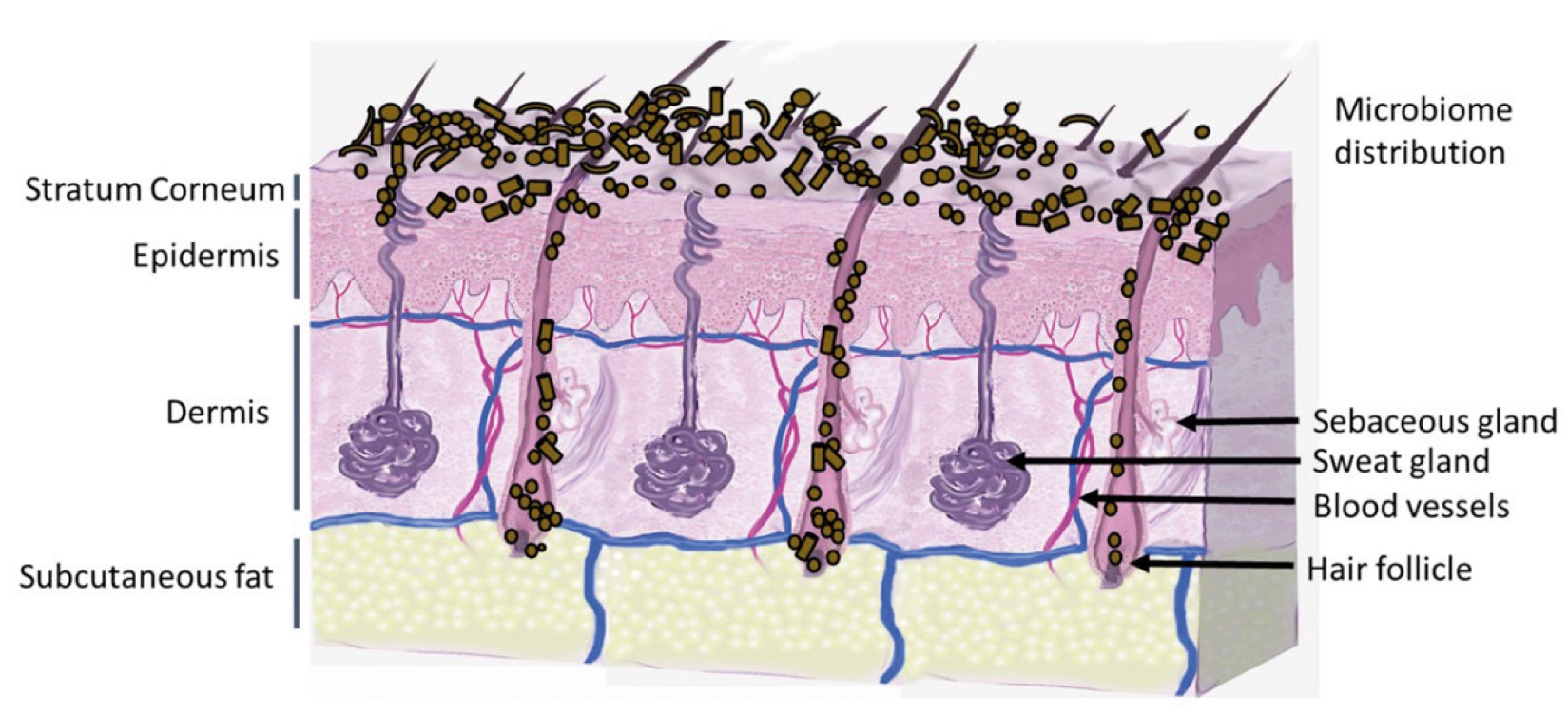
Figure 2. Skin Section with Microbiome. Most microorganisms live in the superficial layers of the stratum corneum and in the upper parts of the hair follicles. Some reside in the deeper areas of the hair follicles and are beyond the reach of ordinary disinfection procedures. There bacteria are a reservoir for recolonization after the surface bacteria are removed.
References and notes
Gamboa, L., et al., Designing Wellness Mind-Body Interventions using neuroscience, artificial intelligence and the power of touch: measurements in real time to ensure skin and emotion transformation, IFSCC Magazine Special Topic Emotional Beauty, 27 (2) (2024) 115-125.
World Health Organization, World Mental Health Report: transforming mental
health for all, (2022) 11 150-152, Available from: https://www.who.int/teams/mental-health-and-substance-use/world-mental-health-report
Herath, H.M.K.K.M.B., Karunasena, G.M.K.B., and Mittal, M., Monitoring the
Impact of Stress on Facial Skin Using Affective Computing, In Predictive Analytics of Psychological Disorders in Healthcare, Data Analytics on Psychological Disorders, Springer Nature Singapore, 2022, 55-85.
Ditre, C., Fried, R., Gordon, M., Koo, J., Mostaghini, L., Rieder, E., Stevenson, M.
L., Wortzel, R., THE MIND-SKIN CONNECTION, MIND, 2022. https://ernolaszlo.com/blogs/news/the-mind-skin-connection
Weng, H.Y., Feldman, J.L., Leggio, L., Napadow, V., Park, J., and Price, C.J., Interventions and manipulations of interoception,Trends in Neurosciences, 44 (2021) 52-62.
Mayo, L.M., Lindé, J., Olausson, H., and Heilig, M., Putting a good face on touch: Facial expression reflects the affective valence of caress-like touch across modalities. Biological Psychology, 137 (2018) 83-90.
Luberto, C.M., Park, E.R., Huffman, J.C., and Yeh, G.Y., Psychosocial Issues in Cardiovascular Disease. In Sex Differences in Cardiac Diseases, Elsevier, 2021, 569-592.
Croy, I., Geide, H., Paulus, M., Weidner, K., and Olausson, H., Affective touch awareness in mental health and disease relates to autistic traits – An explorative neurophysiological investigation, Psychiatry Research, 245 (2016) 491-496.
Dayan, S., Yoelin, S.G., De Boulle, K., and Garcia, J.K., The psychological impacts of upper facial lines: a qualitative, patient centered study, In Aesthetic Surgery Journal Open Forum, US: Oxford University Press, 1 (2019) ojz015.
Charles Finn, J., Cox, S.E., and Earl, M.L., Social implications of hyperfunctional
facial lines, Dermatologic surgery, 29 (2003) 450-455.
Apaolaza-Ibáñez, V., Hartmann, P., Diehl, S., and Terlutter, R., Women satisfaction with cosmetic brands: The role of dissatisfaction and hedonic brand benefits, African Journal of Business Management, 5 (2011) 792.
Chen, Q., et al., Exploring associations between postpartum depression and oxytocin levels in cerebrospinal fluid, plasma, and saliva, Journal of Affective Disorders, 315 (2022) 198-205.
Roca, D., et al., Evaluation of the Effect of a Live Interview in Journalism Students on Salivary Stress Biomarkers and Conventional Stress Scales, International Journal of Environmental Research and Public Health, 19 (2022) 1920.
Gannouni, S., Aledaily, A., Belwafi, K.Aboalsamh, H., Emotion detection using electroencephalography signals and a zero-time windowing-based epoch estimation and relevant electrode identification, Scientific Reports, 11 (2021) 7071.
McGlone, F., Wessberg, J., and Olausson, H., Discriminative and affective touch: sensing and feeling, Neuron, 82 (2014) 737-755.
Hatayama, T., Kitamura, S., Tamura, C., Nagano, M., and Ohnuki, K., The facial massage reduced anxiety and negative mood status, and increased sympathetic nervous activity, Biomedical Research, 29 (2008) 317-320.Ferrell-Torry, A.T., and Glick, O.J.,
The use of therapeutic massage as a nursing
intervention to modify anxiety and the perception of cancer pain, Cancer Nursing, 16 (1993) 93-101.
Henseler, H., Investigation of the precision of the Visia® complexion analysis camera system in the assessment of skin surface features, GMS Interdisciplinary Plastic and Reconstructive Surgery DGPW, 11 (2022), doi: 10.3205/iprs000169.
Uvnas-Moberg, K., and Petersson, M.,Oxytocin, a mediator of anti-stress, wellbeing, social interaction, growth and healing, Zeitschrift für Psychosomatische Medizin und Psychotherapie, 51 (2005) 57-80.
Li, D., et al., The effects of aromatherapy on anxiety and depression in people with cancer: a systematic review and metaanalysis. Frontiers in public health, 10(2022) 1335.
Seyyed-Rasooli, A., et al., Comparing the effects of aromatherapy massage and inhalation aromatherapy on anxiety and pain in burn patients: A single-blind randomized clinical trial. Burns, 42 (2016) 1774-1780.
Enobio® (20 Channels) ,[Apparatus] (2024). Barcelona, Spain: Neuroelectrics®
Russell, J., A Circumplex Model of Affect, Journal of Personality and Social Psychology, 39 (1980) 1161-1178.
Barrett, L.F., and Russell, J.A., The structure of current affect: Controversies and emerging consensus. Current directions in psychological science, 8 (1999) 10-14.
Rivera, J.A.G., Quintero-Jiménez, N., Veray-Alicea, J., and Rosario-Rodríguez, A., Adaptación y validación de la scala de bienestar psicológico de Ryff en una muestra de adultos puertorriqueños. Salud y Conducta Humana, 3 (2016) 1-14.
Betella, A., and Verschure, P.F., The affective slider: A digital self-assessment scale for the measurement of human emotions, PloS one, 11 (2016) e0148037.
Aytekin Tank (2024), JotForm, accessed 6 June 2020, https://www.jotform.com/
Enobio® (20 Channels) ,[Apparatus] (2024). Barcelona, Spain: Neuroelectrics®
Copyright © 1989-2005. INRIA ENPC.Scilab is a trademark of INRIA. www.scilab.org
Chadwick Boulay, Lab Streaming Layer (2024), GitHub repository, https://github.com/sccn/labstreaminglayer
Visia® Complexion Analysis Camera,Canfield Scientific, Inc., New Jersey, USA https://www.canfieldsci.com/
Azarbarzin, A., Ostrowski, M., Hanly, P., and Younes, M., Relationship between arousal intensity and heart rate response to arousal, Sleep, 37 (2014) 645-653.
Sala, J., et al., Sonification of EEG signals as a tool for rehabilitation of patients with motor and cognitive disabilities, Poster presented at Sociedad Española de Neurociencia Conference, Granada, September 2015.
Bos, D.O., EEG-based emotion recognition,The Influence of Visual and Auditory Stimuli, 56 (2006) 1-17.
Chanel, G., Kronegg, J., Grandjean, D.,and Pun, T., Emotion assessment: Arousal evaluation using EEG’s and peripheral physiological signals, In Multimedia content representation, Classification, and Security, Lecture Notes in Computer Science,Springer, Berlin, Heidelberg, 4105 (2006) 530-537.
Frantzidis, C.A., et al., Toward emotion aware computing: an integrated approach using multichannel neurophysiological recordings and affective visual stimuli, IEEE Transactions on Information Technology in Biomedicine, 14 (2010) 589-597.
Kuppens, P., Tuerlinckx, F., Russell, J. A., and Barrett, L.F., The relation between valence and arousal in subjective experience. Psychological Bulletin, 139 (2013) 917.
Koelstra, S.,et al., Deap: A database for emotion analysis; using physiological signals, IEEE Transactions on Affective Computing, 3 (2011) 18-31.
Müller, M.M., Keil, A., Gruber, T., and Elbert, T., Processing of affective pictures modulates right- hemispheric gamma band EEG activity, Clinical Neurophysiology, 110 (1999) 1913-1920.
Benjamini, Y., and Hochberg, Y., Controlling the false discovery rate: a practical and powerful approach to multiple testing, Journal of the Royal Statistical Society: Series B (Methodological), 57 (1995) 289-300.
Tukey, J. W., Exploratory Data Analysis, Mass. - Menlo Park. Cal., London, Amsterdam, Don Mills, Ontario, Sydney: Addison-Wesley Publishing Company Reading, 16 (1977) 688S.
Gupta, M.A., and Gilchrest, B.A., Psychosocial aspects of aging skin. Dermatologic Clinics, 23 (2005) 643-648.
Koblenzer, C.S., Psychologic aspects of aging and the skin. Clinics in dermatology, 14 (1996) 171-177.
Paradise, A.W., and Kernis, M.H., Self-esteem and psychological well-being: Implications of fragile self-esteem, Journal of Social and Clinical Psychology, 21 (2002) 345-361.
Ryff, C.D., Happiness is everything, or is it? Explorations on the meaning of psychological well-being. Journal of Personality and Social Psychology, 57 (1989) 1069-1081.
Morrison, I., Keep Calm and Cuddle on: Social Touch as a Stress Buffer, Adaptive Human Behavior, and Physiology, 2 (2016) 344-362. https://doi.org/10.1007/s40750-016-0052-x
Wozniak-Holecka, J., Romaniuk, P., Holecki, T., Fraczkiewicz-Wronka, A., and Jaruga, S., Health promotion development in the spa treatment. Perspectives for the European countries learned from Poland’s experiences. Frontiers in pharmacology, 8 (2017) 29.

